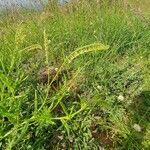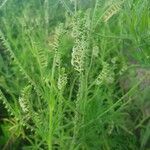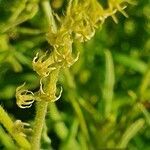Perennial suffruticose herb 25–80 cm. tall, erect or sometimes procumbent at the base with a long thick rootstock or sometimes flowering ?as an annual or in its first year; stems branched, woody at the base, sparsely to densely covered with tubercle-based hairs.. Leaf-blades linear to elliptic or sometimes lanceolate, 0.8–9(–12) cm. long, 0.2–1.2(–1.8 or exceptionally –2.4) cm. wide, acute at the apex, narrowly attenuate at the base, entire, sparsely to densely pubescent with tubercle-based hairs above and pubescent on nervation beneath; petiole obsolete or very short.. Cymes spike-like, one-sided, single or paired, 1.5–30 cm. long; flowers sessile; bracts absent.. Calyx lobed to the base, the lobes narrowly elliptic, 1.5–2.2(–3 in fruit) mm. long, 0.4–0.9 mm. wide, thick, glabrous or pubescent with margins ± undulate, sparsely ciliate, sparsely pubescent toward top inside.. Corolla with white tube and yellow-green limb extending along midrib into throat, or with yellow-brown centre; tube ± cylindrical, slender, 2.8–4.5 mm. long, widened above, pubescent outside in bands corresponding to the lobes; limb spreading, 4–8 mm. (including tails) or ± 2 mm. (excluding tails) wide, the lobes triangular at base, 0.5–1 mm. (excluding tails), caudate-acuminate, the tails subulate or flattened at base, 2–3.5(–4) mm. long, pubescent outside.. Style 0.7–1.5 mm. long, with a conic stigma 1.3–1.7 mm. long terminated by a tuft of hairs.. Fruit subglobose, 1.5 mm. tall, 2–2.6 mm. diameter, glabrous, verrucose, breaking into 4 nutlets.. Fig. 14/3, p. 54; 15.
A erect herb. It keeps growing from year to year. It grows 80 cm tall. It has a long thick rootstock and can be a spreading plant. The stems are branched and woody at the base. They have hairs. The leaves are long and thin. They are 9 cm long and 1 cm wide. They have a sharp tip and narrow at the base. The flowers are small and greenish-yellow. They form along a spike like stalk. The fruit is rounded and 2 mm long. It breaks into 4 nutlets.
Calyx 1.5–2.0 (2.5) mm. long, lobes narrowly ovate, acute, 3-nerved, 3-ribbed outside over the nerves, ribs usually undulate, sometimes only the middle one, rarely not perceptibly undulate, ciliate on the margins and on the midrib, sometimes glandulous outside, pubescent to the apex inside, stellate-spreading after the nutlets are shed.
Leaves sessile or subsessile, 20–65(120) x 2–14(20) mm., linear to linear-lanceolate, rarely lanceolate, pubescent-hispid above, glabrous or subglabrous below, however hispid on the nerves, acute at apex, cuneate at base, margins entire; often small orange sessile or pedicled glands are present mainly on the lower surface.
Erect or procumbent perennial herb, up to 0.6(-0.9) m high. Leaves lanceolate, linear-lanceolate or ovate-lanceolate. Corolla lobes caudate-acuminate. Calyx lobes thin, 3-ribbed. Fruit tuberculate, subglobose; nutlets free. Flowers yellow or greenish; September to January and in June.
Corolla yellow or greenish; tube 3.5–4.5(5.5) mm. long, widened to the upper half, pubescent or strigose outside by strips corresponding the lobes; corolla lobes 1.5–3.0 mm. long, caudate-acuminate, spreading, with the tip bent back inwards, at least in bud.
Stamens inserted between 1/2 and 2/3 from the base on the corolla tube; anthers 1.0–1.5 mm. long, lanceolate to oblong, shortly bifid at apex, subsessile.
Fruits 1.7–2.3 x 2.0–2.5 mm., subglobulous, glabrous, rugose, usually bright brown; nutlets free, with the inner surfaces ± convex, irregular.
Erect or procumbent perennial herb up to 60(90) cm. high, usually with a thick rootstock; stems somewhat woody to the base, hispid.
Style 1.0–2.0 mm. long, glabrous; stigmatic ring small; sterile appendix 0.8–1.3 mm. long, narrowly cone-shaped, brush-like.
Cymes lax, ebracteate, single or more often in pairs, up to 25(30) cm. long when completely expanded.
Ovary ovoid, glabrous.
Flowers sessile.









